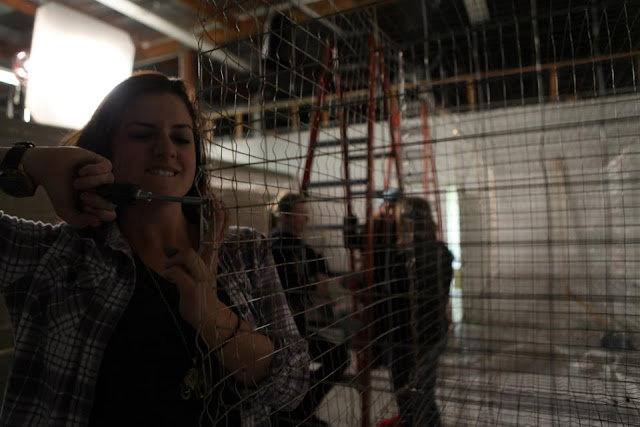The greatest danger, critic and competitor on a movie set is time.
While takes roll, the set is tense, coiled, waiting for their next move. Everyone is riveted on the actors- not because of their performance, but because as soon as a prop fails, an accident occurs, or someone breaks character, the director calls cut (quickly repeated and projected by the AD) and HUSTLE is now the name of the game.
 |
| Shooting in abandoned underground water treatment plants: hazardous for one's health. |
With only 12 hours to get multiple takes, multiple angles, multiple shots and sometimes multiple locations, every second counts. Each minute is scrupulously measured as the movie set is ultimately ruled by time: Time to start, time for actors to be there, time for lunch. On a set, everything costs money- paying the actors overtime, paying the rental company for use of the truck, the camera, the equipment, the space. You want to maintain a positive relationship with these people so that you can work with them again- but you're also balancing your vision of the movie.

This is why it is SO IMPORTANT to plan your shots ahead of time, to communicate with your key creatives to make sure that everyone knows exactly in which direction to head like a great coordinated school of fish. Each movement is beautifully choreographed and not a single second is wasted telling people to be quiet, to re-take the scene, to move out of the shot, to move into the shot. The people, even despite the fact that it's a student film, are professionals. This is their passion, whether they're doing the job on set they want or not, and each movie is another learning experience.

Ideally the main creatives (director, DP (director of photography) and the assistant director) should meet to discuss what the focus of the day is, sort of to keep everyone on the same page. Additional people may be added to this meeting (assistants, the producer, even the key grip) but overall you want a few key people to direct the flow and efficiency of the day. The call-sheet is sent out the night before (if everyone's on top of it), letting the crew and talent (cast) know where they need to be. It also includes important information like start times, directions, who's needed when and where, set changes, lunch, breaks and so on and so forth.
Even though set may start at a specific time, transportation may take longer to get there (if, say, your set is in LA in the traffic of a weekday morning...or a weekend in the mountains).
Once everyone has started arriving, the first shot of the day is set up. The equipment is unloaded from the truck and organized: cables and lights, sandbags and boxes, dolly tracks, mics, the camera(s) and folding chairs. This can easily take a few hours. While this is going on base camp is also being created- chairs off-set, craft services (aka crafty, aka snacks and food) for those who don't have a specific function between shots.


When the camera starts rolling, the crew moves like clockwork (if it's a good crew!). The grips handle the equipment, all led by the key grip who is in charge of organizing where things need to be for each take. This is also overseen by the DP who lends a hand, placing his lights just so, fixing cables and framing where the shots will be. On student sets the grips are often a swing shift of sorts- working both grip and electric departments, filling in for whatever needs moving. The gaffer, who is in charge of the electricalities, adjusts the lights, the bounce boards, and the cables...which can run every which way all over the set.
 |
| The electric crew creates the light, the grips create the shadows. |
The director is often seen conversing with his actors- a good director can trust his crew to do the things he wants, without actually monitoring them. He has other people who monitor for him, so when he's between takes he focuses on molding the talent, leading them one way or another, encouraging or discouraging as the case may be. Once cameras are rolling you'll find him behind a make-shift TV screen, watching what the camera records. He watches the actors, the blocking, the reactions and the movement of the camera and may or may not have someone watching the scene with him to make sure no equipment is captured accidentally.

The lifeblood of a set- the vein that keeps it all together- is the almighty walkie-talkie. Cell phones sometimes get bad reception (when you're working in cement basements) or aren't loud enough. The regular squawking and white noise allows those not immediately on set to socialize, rehearse, get away from where the shots are being filmed- as long as someone is always within the vicinity of a walkie, you're always on call.
My favorite part of listening to the dead silence when a walkie goes off? The short-hand and the funny phrases.
"Can we have a C-47 flown in?" Someone needs a clothespin on set











Hey there, I really enjoyed your post and you have some quality pictures there also. Looks like you and Mr E. have a very interesting life. I will be back when I have a little more time to check out the rest of your site. Best of luck to you both. Thanks Angelia @ http://dixielandcountry.com
ReplyDeleteThanks, Angelia! Can't wait to see more from you!
ReplyDelete